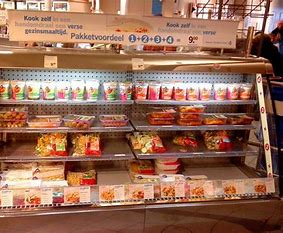We all get drawn into marketing messages and in a busy world it’s hard to make a balanced decision about everything! However here are a few pointers that may help you answer this question…
“Do higher price tags, prettier packaging, famous brands, and promoted features mean that a food is highly nutritious?”
 1.Fat Free
1.Fat Free
This is an older marketing phrase and craze. In some cases a lower fat version may be better, if this is reducing trans or saturated fats. It is also a way to reduce total calorie intake as 1 gram of fat has 8 calories, whereas 1g of protein or carbs has 4 calories. However not all fat is a bad, and healthy fat can be beneficial and essential to many bodily functions. Watch this short video which explores “healthy fats, the story so far”
https://lnkd.in/ea_HzmB
Often the fat is replaced with extra sugar, sweeteners, or flavourings, so check out the ingredients. In addition to this, fat does create satiety, so be aware that although it is higher in calories, you could end up eating more of the low fat version due to not achieving that satisfaction you need.
- High in protein.
Just because a label says high in protein, this does not necessarily mean it is a good quality protein, or has all the 9 essential amino acid proteins that our body needs e.g. a highly processed meat snack, or protein powder with loads of flavourings and sweeteners added, maybe not as nutritious as simply eating a couple of eggs!

Always try to choose a minimally processed protein e.g. eggs, natural yoghurt, milk. If you are vegan and want to get all the essential amino acids, try to mix up grains and pulses e.g. brown rice, lentils, beans.
Do not be tricked into that protein bar which you can easily make 20 at home for the price of 1 in the shop. Simply make in bulk, wrap individually and freeze until you want one. Also do not fall into the trap of buying a label that says high in protein, when that type of food is naturally high in protein anyway and the cheaper brands without the protein label contain the same levels. Peanut butter is a great example.
- Vegan
Veganism is super trendy right now and we are constantly seeing food labelled as vegan. In many cases this has a positive effect on overall nutrition as generally by defect it means that people consume more plants, which as we know are nutrient dense. However, not all vegans base their diet around plants, and choose the foods labelled vegan such as sweets, highly processed meat alternatives, some vegan desserts that are full of sugars, flavourings & sweeteners, & some plant based milk with added sugars
- Portion size
Often on cereal packets it shows on the front the calories per bowl, which can look pretty low and sugars moderate. BUT these are usually based on a 30 gram serving which is the size of a variety pack serving, and it unlikely to fuel you until lunch. If you are opting for a sugary cereal, it is very easy to have a high amount of sugar to get the satiety that you need, and this leads to peaks and troughs in your blood sugar levels which impact on mental and physical health.
Always look carefully at the actual portion size as marketers often show a nutritional value for a smaller serving size than is consumed.
- Organic
Organic food is often a lot more expensive than non-organic, so it may not be possible to buy all the time. Pesticide levels are regulated in the UK; however some studies have shown links between high pesticide consumption and hormone disruption, respiratory problems, and some cancers.
If you want to prioritise your spending here is a list of the “Dirty Dozen” which shows the fruits and veg that were highest in pesticides in 2018 and 2019
Pesticides-in-our-food-FINAL.pdf (pan-uk.org)
These included (from highest percentage to the lowest) Grapefruit Clementine’s, mandarins and satsumas Strawberries Pre-packed salad Grapes Lemons Peaches and Nectarines Pears Spinach Chilli Peppers Apples Blackberries and blueberries.
Fruit
- No added sugar
Sugar is deemed to be the enemy right now, so “No added sugar” may seem the best option. Be aware though that a bag of sugar could actually be labelled *no added sugar” as it has had no extra sugar added! Also added sugar may be substituted for artificial flavourings and sweeteners which do not come without caution. Try to choose a low sugar option without lots of poor substitutes. It’s also good to remember that you can sweeten things up with fruit. E.g. natural yoghurt with berries, rather than no added sugar yoghurt.

- Multigrain
Multigrain just means a mixture of grains, but does not necessarily mean Wholegrain, so can still be grains removed of the kernel including germ, bran and endosperm. In addition to this many multigrain things can be highly processed and added with saturated fats such as crisps, or added sugars such as cereal bars.
- List of ingredients
Food ingredient lists are ordered in terms of content in the food. So, if the first few ingredients are sugars, E numbers, trans fats, saturated fats, this may be a warning sign and be mindful of the amount you are consuming.
- Traffic light system
It is advised that all foods follow the traffic light system, but in reality this does not always happen. Those that do not adhere with this may be afraid to show this transparency, so you may have to find the information you want on the nutritional value section.
- Branded/ Unbranded
Often there is no difference. Oats, are usually oats whatever brand, Weetabix is usually the same ingredients branded or unbranded etc. So the is no need to always just look at the pretty picture, but look at the ingredients and nutrition information.
So, the take home message is that things are not always as they seem!
The higher the cost, the prettier the packaging, the brand, and the promoted features do NOT always mean that it is the most nutritious.
Anna

For more information about workplace health workshop’s or 1:1 Nutrition coaching to improve physical & mental health, and drive personal & professional productivity
contact me at anna@leaphealth.co.uk.
Current workshops include
WFH…WFH-Working From Home…Without Forgetting Health – Leap Health
Food for Mood & Motivation – Leap Health
Exercise snacking for productivity hacking – Leap Health
Rest, Recovery, Recharge… – Leap Health
Fuel as a Productivity Tool – Leap Health
Perimenopause, menopause & post menopause nutrition to nourish and flourish. – Leap Health
Bespoke solutions include
A four part programme to empower the women in your workplace to flourish personally & professionally through the years
A customised build workshop for your workplace
Support building internal health champions
Initiatives and events to improve corporate health
Heart rate monitoring and stress testing
Connections to other health experts in the field
Or… other innovative, individualised solutions based on your organisation needs
Linkedin- Anna Reddy Leap Health
Instagram- leaphealth.co.uk
Website- www.leaphealth.co.uk
Email- anna@leaphealth.co.uk
